1.9 - Strategic Policy Context
1.9 - Strategic Policy Context
1.9.1 Introduction
Since the adoption of the current Dublin City Development Plan in 2016, significant changes have occurred in the policy and regulatory environment for land use planning and development in Ireland. The plan is informed by a hierarchy of international, national and regional policies, which are now in place.
Figure 1‑3: Key National, Regional and Local Planning Policy
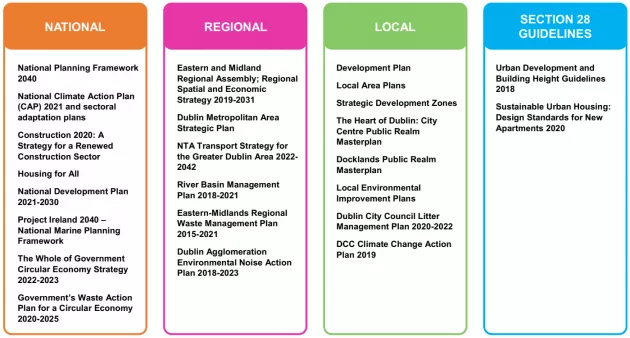
1.9.2. UN Sustainable Development Goals
The 17 United Nations Sustainable Development Goals (SDGs) set out a holistic approach to achieving a sustainable future for all. Ireland is committed to achieving the SDGs as set out in the Department of Communications, Climate Action and Environment ‘The Sustainable Development Goals National Implementation Plan 2018-2020. There is significant alignment between the NPF’s National Strategic Outcomes and the SDGs (see also https://sdgs.un.org/goals).
|
It is the Policy of Dublin City Council: |
|
|
SCV1 |
Policy SCV1 United Nations Sustainability Goals (See also Chapter 3, Climate Change): It is the policy of Dublin City Council to contribute, via this development plan, towards achievement of the 17 Sustainable Development Goals of the United Nations’ 2030 Agenda for Sustainable Development as per link https://sdgs.un.org/goals |
Figure 1 4: UN Sustainable Development Goals
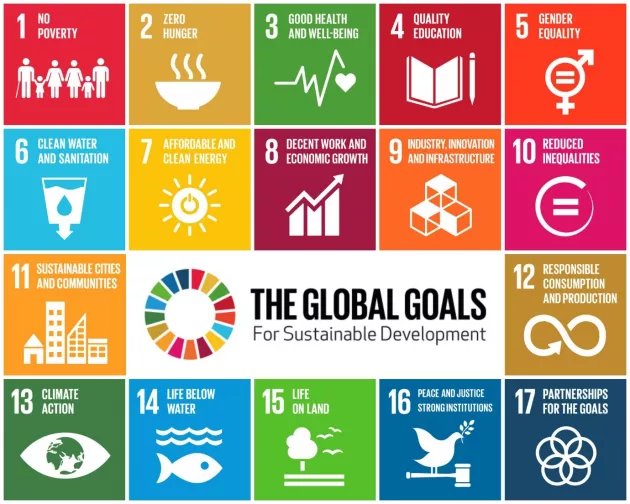
1.9.3 The National Planning Framework
The National Planning Framework (NPF) is a 20-year, high-level strategy to guide development and investment in Ireland. The full document can be viewed at https://npf.ie/.
The NPF makes a strong commitment to sustainable land management and resource efficiency in order to support the transition to a low carbon society. It sets out a regional focused strategy for managing growth and providing a counterbalance to the established concentration of growth in the Greater Dublin Area.
Notwithstanding this, the NPF acknowledges the critical role that Dublin City plays in the country’s competitiveness as the country’s leading global city of scale, and supports Dublin’s growth in jobs and population, anticipating that the city and suburbs will accommodate an extra 235,000 to 293,000 people by 2040.
The NPF identifies ten National Strategic Outcomes (NSOs) for the future growth and sustainable development of Ireland to 2040. These outcomes have been a central consideration in shaping the new Dublin City Development Plan.
The Outcomes in the NPF are realised through a series of National Policy Objectives (NPOs) with which the Dublin City Development Plan is consistent with.
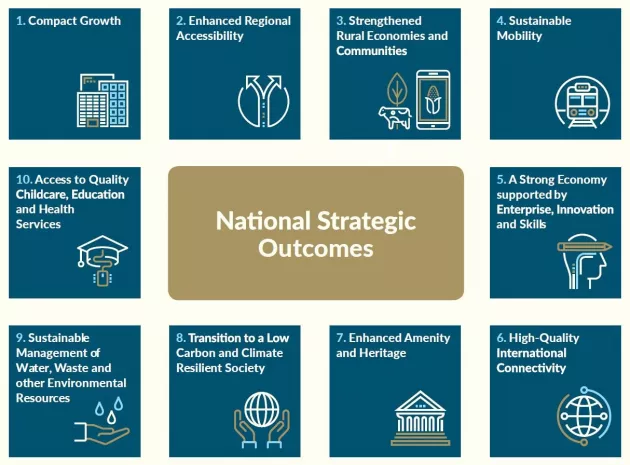
Compact growth is the first NSO and it has particular significance for spatial planning policy, requiring at least half of all future housing and employment growth in Dublin to be located within and close to the existing ‘built-up’ area of the city – specifically within the canals and the M50 ring which will require the progressive relocation of less-intensive land uses outside of this built-up area.
This growth strategy will allow better use of underutilised serviced land and buildings, including infill and brownfield land, with more high-quality and higher-density mixed-use development accompanied by enhanced amenities, education, health and social services; all supported by sustainable mobility.
The NPF sets out that securing compact and sustainable growth requires a focus on the liveability of urban places, continuous regeneration of existing built up areas, tackling legacies such as concentrations of disadvantage in certain areas, and linking regeneration and redevelopment initiatives to climate action. The NPF also sets out a series of growth enablers for Dublin, which have informed the policy approach in the plan.
1.9.4 The National Climate Action Plan 2021
The National Climate Action Plan (CAP) 2021 (https://www.gov.ie), sets out a course of action to address the impacts of climate change on Ireland’s environment, society, economic and natural resources. The CAP identifies the scale of the challenge and examines impacts on a range of key sectors including electricity, transport, built environment, industry and agriculture and charts a course towards ambitious emission reduction targets.
The CAP recognises the role that Project Ireland 2040 and the NPF can play in climate action in providing for population growth in a compact, connected and sustainable way and the key role that land use planning can play in progressing climate change mitigation and adaption.
The CAP provides a detailed framework which identifies how Ireland will achieve a 51% reduction in Ireland’s overall GHG emissions from 2021 to 2030, and to achieve net-zero emissions no later than 2050. These legally-binding objectives are set out in the Climate Action and Low Carbon Development (Amendment) Act 2021.
Dublin City Council adopted and is implementing a Climate Change Action Plan (CCAP) for the city for the period 2019-2024 focussed on the areas of energy and buildings, transport, flood resilience, nature-based solutions and resource management.
Climate action is a cross-cutting theme and is integrated with every chapter of the plan. In particular, the plan promotes a compact urban form, the integration of transportation and land use planning, protection and enhancement of biodiversity, all of which will help create climate resilient communities and neighbourhoods.
1.9.5 Regional Spatial and Economic Strategy (2019-2031)
Dublin City is within the Eastern and Midland Regional Assembly Area (EMRA) and the Regional Spatial and Economic Strategy (RSES) (https://emra.ie/final-rses/) for this area sets out a strategic plan and investment framework to shape the development of, and to manage planning in, the region.
Figure 1 6: Dublin City in the EMRA Area
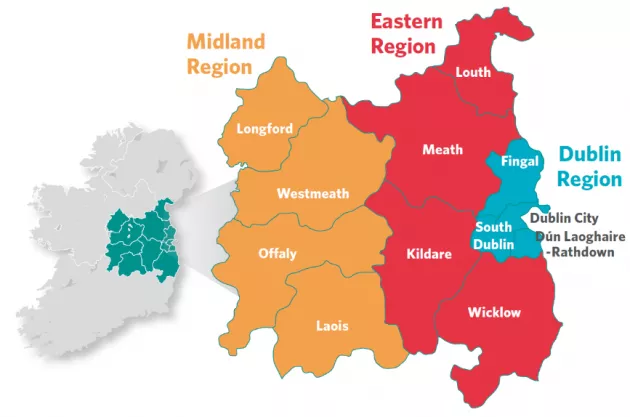
The RSES integrates the NPF objectives and the growth and Settlement Strategy at the regional level, ensuing coordination between the NPF and the Dublin City Development Plan.
The RSES identifies the region’s challenges as the need to sustain economic growth whilst transitioning to a low carbon society and; the need to align population growth with the location of homes and jobs whilst creating healthy attractive places and an enhanced quality of life.
The RSES is underpinned by three key principles namely: placemaking; climate action; and sustainable economic opportunity and growth. Sixteen Regional Strategic Outcomes (RSOs) are set out which are broadly aligned with the National Strategic Outcomes of the NPF.
Figure 1 7: EMRA RSES Regional Strategic Outcomes
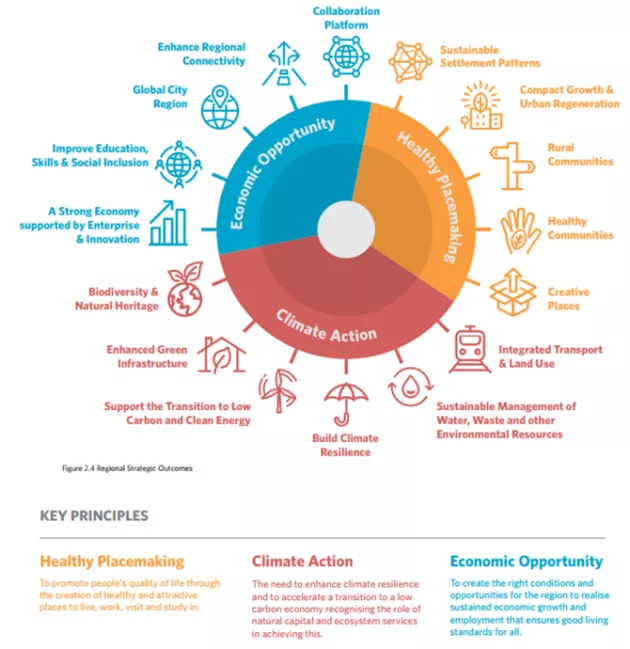
The RSES sets out the vision for growth (homes and jobs) and Regional Policy Objectives (RPOs) for the Region to the year 2031 and seeks a population increase of circa 100,000 people by 2031 in Dublin City.
The policies and objectives of the plan align with the RSOs and the core strategy is underpinned by the population targets set out in the RSES.
1.9.6 Dublin Metropolitan Area Strategic Plan (MASP)
The RSES includes a more detailed Dublin Metropolitan Area Strategic Plan (MASP) which identifies strategic development and employment areas for population and employment growth, in addition to more generalised consolidation and re-intensification of infill, brownfield and underutilised lands within Dublin City and its suburbs.
Figure 1 8: Dublin MASP
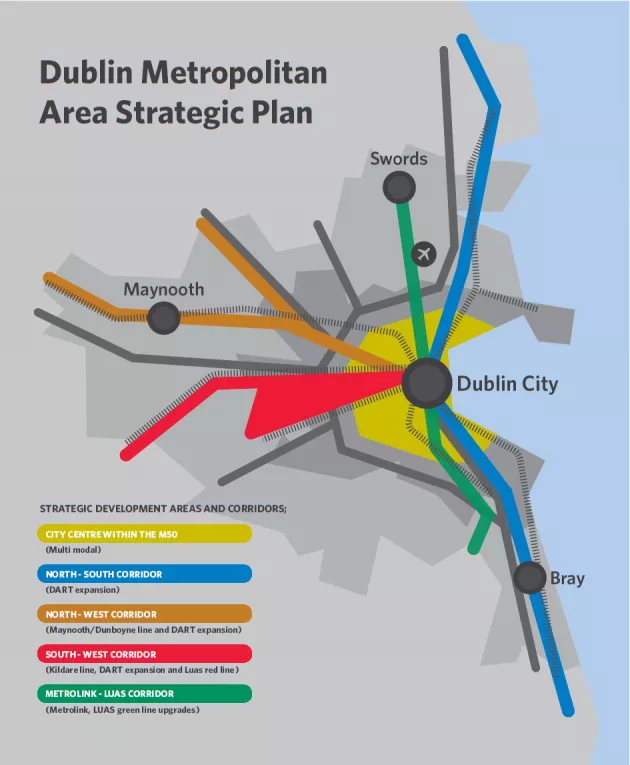
The MASP identifies a number of large scale strategic sites (strategic development lands), based on key corridors that will deliver significant development (housing and employment development) up to the year 2031.
The strategic development lands within the city council’s area identified in the RSES by EMRA are as follows:
Strategic Development Areas
Multi-Modal Location – City Centre within the M50
- Residential: Docklands and city centre, Naas Road, North East Inner City lands, Parkwest – Cherry Orchard, Ballymun, Ashtown-Pelletstown and St. James’s – Heuston Lands.
- Employment: Docklands and Poolbeg, Diageo lands and St. James’s and Grangegorman campus, Naas Road.
DART Corridor – (North South)
- Residential: North Fringe (Clongriffin / Belmayne)
- Employment: North Fringe Mixed Use Centres
Strategic Employment Lands
Multi-Modal Location – City Centre and Docklands
- Docklands, Poolbeg and North East Inner City, city centre (Grangegorman and St. James’s-Diageo lands)
- Intensification of Industrial lands
- DART Corridor- (South West Corridor)
- Naas Road.
These Strategic Development Areas and Strategic Employment Lands are incorporated into the city development plan as SDRAs – see Chapter 2, Core Strategy and Chapter 13, Strategic Development Regeneration Areas.
The MASP supports a sequential approach to residential development with a primary focus on the consolidation of sites within or contiguous to Dublin City and Suburbs. The core strategy and Settlement Strategy of the plan aligns with the strategic development lands detailed in the RSES.
1.9.7 NTA Greater Dublin Area Transport Strategy 2022 – 2042
The Greater Dublin Area Transport Strategy 2022 – 2042 provides a framework for a sustainable transport network for the long term. Key projects include:
- MetroLink from Charlemont to Swords via Dublin Airport, with construction date due to commence during the development plan period;
- The BusConnects programme which includes the following:
- Dublin Area Bus Network Redesign which provides for significantly enhanced bus services, with a completion date by 2024 and
- The Core Bus Corridor Projects which will provide bus priority on the radial routes, with a completion date by 2030;
- DART+ Programme, with construction to commence during the development plan period and
- Luas Finglas with a Railway Order due to be submitted by 2030.
- Greater Dublin Area Cycle Network Plan.
Over the course of the development plan, it is expected that these key infrastructural projects will either be delivered or be at an advanced stage of design/planning. The alignment of future growth and key public transport infrastructure is a key consideration of the plan.
1.9.8 Statutory Planning Guidelines
The Minister for Housing, Local Government and Heritage has issued a range of guidelines which planning authorities are required to have regard to in carrying out their functions, including in the preparation of the Dublin City Development Plan. These guidelines cover a wide range of issues including building height, residential density and design, development management, childcare facilities and environmental assessment. Full cognisance of these guidelines and all relevant strategic planning policy requirements has been had when framing the policies and objectives of the plan (see Appendix 14).
1.10 Implementation and Monitoring
The numerous strategies, policies and objectives in the Dublin City Development Plan cannot be delivered by the City Council alone. The vision of the plan will be implemented by a number of agencies at the city, region and national level. The successful implementation of a significant number of the policies and objectives of the plan will necessitate ongoing collaboration and a sense of goodwill across a range of agencies and stakeholders.
Dublin City Council will actively engage with the relevant agencies and undertake an active land management role to progress and secure the implementation of the plan. Monitoring mechanisms will be put in place to ensure effective sustainable delivery and also to allow for greater transparency on the progress made in the implementation of the plan (see Chapter 16: Monitoring and Implementation).